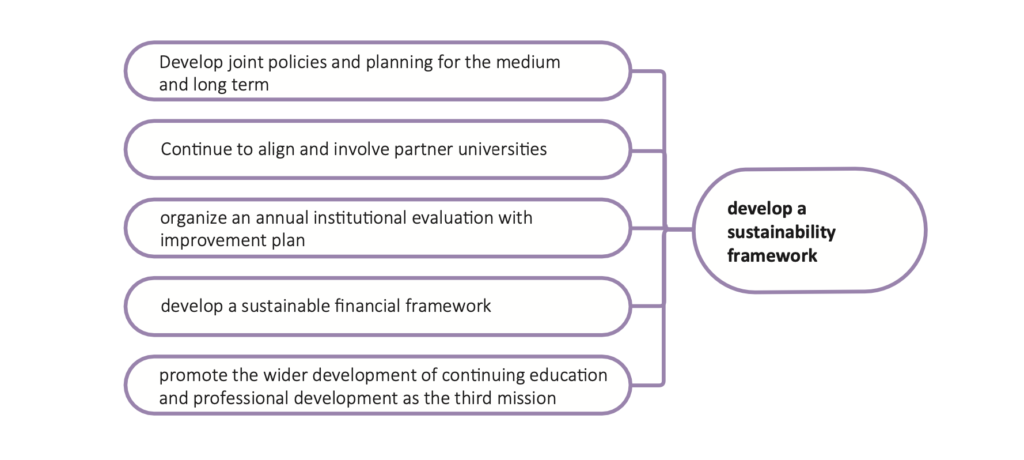
| The partnership develops a sustainability framework based on a strong basis: |
| Develop joint policies and planning for the medium and long term; |
| Continue to align and involve partner universities; |
| Organize an annual institutional evaluation with an improvement plan; |
| Develop a sustainable financial framework; |
| Promote the broader development of continuing education and professional development as the third mission. |
Guidelines
Develop joint policies and planning for the medium and long term
The partner universities define a medium- and long-term policy and planning for the joint programme with qualitative and quantitative milestones related to attracting (inter)national students, income streams, study progress and success, learning agreements with third universities, collaboration with stakeholders and other factors to consider.
Continue to align and involve partner universities
The partner universities remain aligned and committed to the shared objectives, main structure and pedagogical principles of the programme and the qualifications awarded. They regularly assess the relevance of the programme to the partnership and individual universities.
Organize an annual institutional evaluation with an improvement plan
The partnership conducts an annual course and programme evaluation with recommendations for improvement. The assessment may address dimensions such as programme relevance and coherence, alignment with the technology ecosystem for course delivery, staff-student interactions, learning communities and discussion forums, student learning
experience and workload, and the inclusiveness of the programme.
The E-xcellence instrument and the European Maturity Model for Blended Education can contribute to this evaluation.
Develop a sustainable financial framework
The partnership should develop a medium and long-term financial plan, based on the original business plan, comprising revenue streams from public funding, tuition fees, external stakeholders and sponsored grants. The plan also relates to the allocation of cash flows to individual partners.
The institutional frameworks for continuing education must also ensure that programme revenues are allocated to the faculty and to the joint programme team according to the financial planning.
The plan will also be flexible, taking into account foreseen and unforeseen changes. Therefore, it should be reviewed annually with advice from financial experts.
Promote the broader development of continuing education and professional development as the third mission
Partner institutions should promote the institutional development of continuing education as a comprehensive offering, alongside regular degree programmes and in line with the university’s social mission to meet large-scale needs in society and in the economy.
Micro-credential programmes will be structurally embedded and supported in such an approach, which will also support them in this comprehensive continuing education structure.
In this perspective, the partnership should also participate in the upcoming discussions on micro-credentials at national government level to ensure a national framework for the recognition and funding of continuing education.
next chapter: Conclude a consortium agreement
previous chapter: Develop a student recruitment plan
back to overview: Models and guidelines for the design and development
of a joint micro-credential programme in higher education
